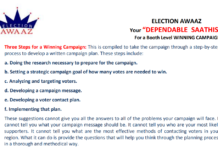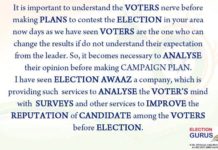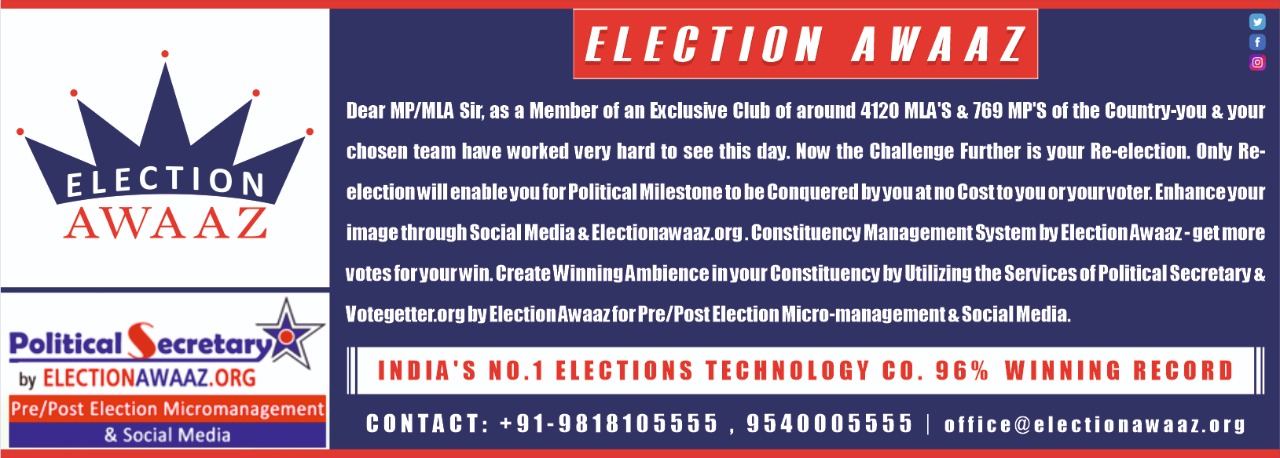The Lok Sabha appointment of 2019 is being held in a country that is totally different from what it was in 2009 and 2014. What are ideological groups offering the new electorate? What will the result uncover of the change that has occurred?
The overall appointment of 2019 is being held in India which has been changed diversely. To express the self-evident, India has gone through a major change in the course of recent many years.
Expressing this reality and taking note of its specificities is imperative to comprehend the idea of appointive battling today. This is an India where the greater part of the populace is under 25 years and 66% is under 35 (Sharma 2017); the working class is developing, however the assessments of the size of the working class differ, going from 5% – 6% to 25% – 30% of India’s populace (Jodhka and Prakash 2016: 7); Census information (2011) shows that over 30% of India’s populace lives in metropolitan regions, the number could be a lot higher if one somehow managed to take a gander at satellite information and loosen up the authority meaning of a metropolitan settlement (Sreevatsan 2017); the quantity of advanced cell clients is relied upon to twofold from 404.1 million out of 2017 to 829 million of every 2022 (IANS 2018); horticulture’s offer in GDP has declined to as merger as 15% (Statistics Times 2019), and the quantity of individuals drawing food from farming and unified exercises has come down to about 56% (Census information 2011), this would be even lower on the off chance that one just views at those with agribusiness as their essential occupation in 2018-19.
Proficiency and expertise levels have developed but the coordinated and secure area of business has contracted and it is the disorderly area that has invested about 82% of the labour force in 2011-12 (PIB 2016).
Today, we see an India which is all the more politically cognizant, youthful, metropolitan, working-class, moving, more talented, more associated, and presented to innovation when contrasted with even the last two decisions in 2009 and 2014.
There is a rise in the number of individuals coming out to cast a ballot, an ascent in the number of ideological groups challenging races, and an increment in the number of appointive debates each political race, all of which highlight a rising pattern of politicization.
Today, we see an India which is all the more politically cognizant, youthful, metropolitan, working-class, progressing, more talented, more associated, and presented to innovation when contrasted with even the last two decisions in 2009 and 2014. This additionally brings into the image the distinct reality that the current framework of instruction, lodging, wellbeing, transport, and chances of work is not satisfactory to oblige this evolving demography.
A conversation on appointive lobbying for the 2019 races consequently needs to put the mission in a setting of a changing India. What are ideological groups offering this changed electorate? What have they been zeroing in on and how would they address the electors’ desires? What is the plan and language of missions in these decisions? How far would they say they are lined up with the issue’s citizens relate to? Posing these inquiries while examining electing battling is significant. In Rai’s words (2009: 80), “there is consistently a chance of a disjunction between the issues projected by parties as significant and the issues that citizens feel are critical.”
The article tends to a portion of these worries. It first glances at a portion of the mission issues in the 2004, 2009, and 2014 decisions, and afterward goes to the current parliamentary political race to check what has changed and what has not in discretionary battling today.
POLITICAL RACES IN 2004 AND 2009
The 2004 parliamentary political race is best associated with the then National Democratic Alliance (NDA) government’s “India Shining” trademark. The working class-driven appointive mission of the time zeroed in on metropolitan India from where the BJP drew its significant help. The mission attempted to project “advancement” and “development” as the characterizing highlights of another and forthcoming India. It enchanted the working class and business circles; it was especially celebrated by the expert and city-abiding segment. The NDA proclamation incorporated a guarantee to Hindutva through a vow to develop the Ram sanctuary at Ayodhya. The BJP felt sure of huge success as did the surveyors. The prevalence of the at that point executive, Atal Bihari Vajpayee, added to this lightness. In any case, enormous segments of the country populace and those battling with job issues wherever saw small significance in the “sparkling” motto. Agrarian trouble and developing disparities had antagonistically influenced them, “advancement” had cruised them by, and the shimmering brand of India as flooding ahead didn’t summon a lot of eagerness among them. This got obvious in their democratic decisions. Belying all assumptions, the NDA government was removed from power in 2004 and the United Progressive Alliance (UPA) government got to work.
The 2009 political decision was strongly challenged. Top heads of all gatherings battled across states. The Congress-drove UPA zeroed in on its formative activities in its five years of rule, for example, in the Mahatma Gandhi Rural Employment Guarantee Scheme, Right to Information, and so on It attempted to connect with provincial India through its calm mission named Bharat Nirman that guaranteed further government assistance measures to improve life in town India. Taking on the BJP, the UPA accentuated mainstream and liberal patriotism as against “limited communalism”. This mission was repressed, and it brought issues up in a calm and careful manner. Despite the fact that there was no “wave” for the occupant government, there was likewise no staggering resistance to it.
The NDA lobby, then again, was centred more around the authority of the Congress and on issues like illegal intimidation and public security coordinated at the Congress and focusing on adjoining Pakistan. Its driving constituent, the BJP, named Manmohan Singh as the most vulnerable leader ever. The public authority was marked as frail and hesitant. The survey crusade was discoloured by disdain discourses also, similar to those of BJP’s Varun Gandhi (in Uttar Pradesh) and Anant Kumar Hegde (in Karnataka), who gave fiery addresses against Muslims while battling. The National Election Study, 2009 uncovered that for the citizens, the swelling was the preeminent issue followed by fear-monger assaults, yet this didn’t antagonistically influence the fortunes of the decision UPA (Rai 2009: 80-2), which got a higher-order contrasted with 2004. The well-known plans of the UPA government were valued by the individuals who cast a ballot back to control (Rai 2009: 82).
‘MODI-DRIVEN’ CAMPAIGN IN 2014
The 2014 political race was gone before by the “India Against Corruption” crusade drove by social extremist Anna Hazare. In spite of the fact that the mission began in 2011 with its operational hub in Delhi, its impact kept going till 2014 and it enormously profited the BJP. The mission found a major reverberation among working-class metropolitan India. It started with the plan of building up a free organization to manage political debasement (the Jan Lokpal) including profoundly positioned chose agents and in this way centered around eliminating the “bad” UPA-II from power in the 2014 parliamentary political race. Despite the fact that the mission created gaps inside, it accomplished accomplish crafted by building negative exposure against the decision Congress party over issues like defilement in the distribution of coal alliances and 2Grange, and in the 2010 Commonwealth Games. “Business,” “value rise” and “improvement” additionally went to the front alongside “debasement” as issues for electors. The BJP upheld the Hazare lobby against the Congress and attempted to fortify its own picture as “a gathering with a distinction”. While doing this it focused every one of its energies on extending Narendra Modi as its undisputed chief. The at that point Prime Minister, Manmohan Singh really missed out on the BJP media raid in approach the 2014 decisions.
In 2014, proficient promoting hands skilfully changed Modi from a provincial, traditional, revolt coordinating government official to a solid, improvement driven patriot pioneer who could associate with youth.
As called attention to by a few, this was a “Modi” political race whose mission was “American-style” and “customized” (Andersen 2015:50), the gathering depended intensely on him (Jaffrelot 2016). The mission was to a great extent libertarian as well. Narendra Modi vowed to bring back dark cash and store Rs 15 lakh in the record of each resident and furthermore swore to make one crore occupations for every year. Alongside this, “Brand Modi” was made and showcased efficiently and adequately with the motto “abdominal muscle ki Baar, Modi Sarkar.” In 2014, proficient publicizing hands skilfully changed Modi from a territorial, conservative, revolt organizing legislator to a solid, improvement driven patriot pioneer who could associate with youth (Pande 2014). Web-based media assumed a significant part in the 2014 races by promoting Modi’s picture as a solid and improvement focussed pioneer in Gujarat who could recreate the “Gujarat model” in the remainder of the country. It was instrumental in scattering the political message all over, connecting particularly to more youthful electors. It started supplanting the prior mission styles of public conventions, divider composing, and house to house visits with “balanced” message crusading. While the metropolitan territories were overflowed with web-based media messages, crusades in the semi-metropolitan regions and towns were observed and taken care of by the RSS units (Narayan 2014: 12-13).
Techno-battling was one of the features of the BJP’s electioneering. Life-size 3D advanced models of Modi, likewise called visualizations, were utilized to battle in territories he was unable to visit. Advanced and lighting innovation made sets/stages where he would address the individuals and give talks through multi-dimensional images. The experience was accounted for to be so life-like that the individuals who went to these capacities were left awestruck and confounded once the sets and the multidimensional image vanished. This was viewed as adding to the Modi “wave” in 2014. The 2014 political decision was the costliest ever, equaling the spending in the American official appointment of 2012. The BJP spent over Rs 714 crore in the 2014 parliamentary and state gathering decisions, the Congress spent Rs 516 crore, the Nationalist Congress Party (NCP) Rs 51 crore, and the Bahujan Samaj Party (BSP) Rs 30 crore as indicated by the authoritatively detailed Election Commission figures (PTI, 2015). A free gauge put complete use, including the informal expenses outside ECI standards, at $5 billion or Rs 30,000 crore in the trade paces of that time (PTI 2019).
Political race information for 2014 uncovered that there was solid help for the BJP and for Narendra Modi among the metropolitan working classes and the more youthful electorate among them (Sridharan 2014: 74). In this Modi wave, the UPA lost the overall political race to the NDA with Congress crushed to holding only 44 seats in the Lok Sabha. Unexpectedly, a flat out dominant part Hindu patriot government drove by the BJP came to control at the middle. The new Aam Aadmi Party (a branch of India Against Corruption development, which vowed to uncover join and practice “clean” legislative issues) shaped the public authority in Delhi in 2013 (with the help of the Congress), and with a mind lion’s share of its own in 2015.













